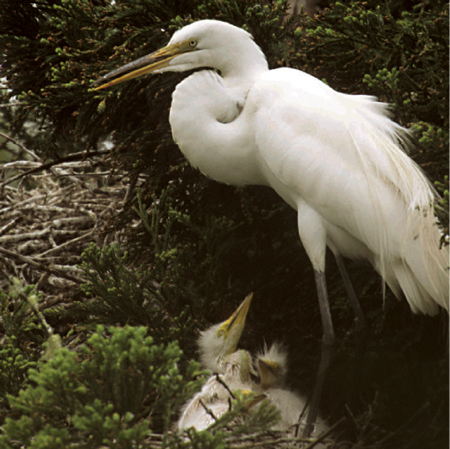Quick question: How do herons and egrets differ? Both are big birds with long necks and skinny legs and both wade in tidal marshes and wetlands throughout the Bay Area. When they fly off, their wingspan can reach six feet.
“Frankly, they’re very similar,” says Skip Schwartz, executive director of the 1,000-acre Audubon Canyon Ranch on the Bolinas Lagoon, three miles north of Stinson Beach along Highway 1. “But great blue herons are slightly larger and are also gray in color.Egrets are the white ones.” (Need a memory jogger? Think of the American author E. B. White—E(gret) B(ird) White.)
Other than that, says Schwartz, these two members of the Ardeidae family are birds of a feather. “With both egrets and herons it’s nearly impossible to tell males from females,” he says. “Both mate in seconds. Their three, four or five eggs are hatched four weeks later. And both egret and heron males and females participate in the 28-day incubating process, which involves not only providing warmth, but rotating the eggs to ensure that chicks don’t ‘flatten out’ against one side of the shell.” Once hatched, only two or three of the chicks survive even though an adult is always near the nest. After 10 to 12 weeks, the young egrets and herons are able to fly and fend for themselves. Interestingly, no one knows for sure where the birds go when their nesting season ends.
During that nesting season, February through July, herons and egrets flock to Audubon Canyon Ranch’s Bolinas Lagoon Preserve, the region’s most important great egret and great blue heron nesting site.
It was the lasting impression these nesting birds made on a 13-year-old Boy Scout from Oakland in 1933 that later led to creation of the preserve. He came upon dozens of herons and egrets feeding in the Bolinas Lagoon, and the experience never left him.
In 1940, the Scout, Martin “Marty” Griffin, had grown into a Stanford premed student who revisited the area on an ornithology field trip. In that visit Griffin saw more than 100 pairs of herons and egrets nesting high up in a concentrated grove of redwoods overlooking the lagoon. The grove was located in that same dairy farm named Canyon Ranch. “At the time,” says Griffin, now 87, retired and living in Belvedere, “little did I dream that saving those birds and their home would become the passionate goal of my life.”
In the late 1950s, as a young internist practicing at the Ross family clinic, Griffin became incensed by county plans to build a freeway along Highway 1 between Stinson Beach and Bolinas and turn Bolinas Lagoon into an upscale yacht marina.
“I knew one way to stop the freeway was to buy land in its path,” Griffin says, “and if that land held the heronry, so much the better.”
Along with risking his life savings on a down payment, in 1961 Griffin and San Francisco businessman Stan Pitcher convinced several Bay Area Audubon chapters, including Marin’s, to acquire 503 acres of the Canyon Ranch for $335,000, or about $666 an acre. “Even for the times,” a smiling Griffin says, “the price, terms and conditions were very favorable.” The purchase not only helped stop the freeway and marina from being built, but it preserved the birds’ nesting place. (An in-depth account of this and other historic approaches to precluding development can be found in Saving the Marin-Sonoma Coast, L. Martin Griffin, M.D., 1998, Sweetwater Springs Press.)
The herons and egrets will be nesting this year through mid-July. “It’s still quite noisy and active up there,” says Canyon Ranch’s Schwartz. At the preserve, located at 4900 Highway 1 just north of Stinson Beach, the mighty birds can be viewed after a short hike to Henderson Overlook (elev. 200 feet), which is equipped with telescopes and binoculars; well-informed docents are available on site to answer questions.
For more information, call 415.868.9244 or visit egret.org.


